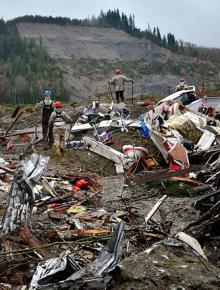The not-so-natural causes of a natural disaster
examines the facts about the deadly mudslide in Washington state.
"IT WAS considered very safe. This was a completely unforeseen slide. This came out of nowhere." So said John Pennington, head of Snohomish County's Department of Emergency Management, in the aftermath of the tragic mudslide near Oso, Wash., on March 22.
His words were a complete lie.
Two weeks after the slide, as rescue workers continue their search for the missing, damning evidence has surfaced as show exactly how unnatural--and preventable--this disaster was.
The slide in Oso--located an hour's drive north of Seattle--left at least 30 people dead and 13 still missing to date, making it the deadliest single mudslide in U.S. history. The area where it took place, ominously dubbed "Hazel Landslide" or "Slide Hill," was known for decades to be prone to landslides. Geological reports going back to 1950s documented the risk, and a 1999 report filed with the U.S. Army Corps of Engineers warned in no uncertain terms of "the potential for a large catastrophic failure."
A 2004 Flood Management Plan drafted by Snohomish County officials recommended buying up homes in the area to prevent just such a disaster. Instead, county authorities chose the less expensive option of trying to stabilize the base of the slope while allowing the homes to stay--even after a 2006 landslide ripped through the same area.

If the official in charge emergency management for the county had no knowledge of this history, that's scandalous in itself--but perhaps not surprising.
Prior to his current position, Pennington was appointed director of the Federal Emergency Management Agency (FEMA) for the entire Pacific Northwest by then-president George W. Bush. At the time, local news outlets drew comparisons between Pennington and Michael Brown, another unqualified political appointee notorious for his botched response to Hurricane Katrina.
Prior to his appointment, Pennington had been a four-term Republican state representative and coffee shop owner, who received a degree in business administration from a then-unaccredited correspondence school that investigators from the federal government's General Accounting Office called a "diploma mill." Pennington was tapped for his current position by former Snohomish County Executive Aaron Reardon, who was driven out of office last year over corruption charges.
THE LIST of political failings in Snohomish County dates back much further than Pennington, however. Often enough, their source is the very same one involved in the landslide itself--the deep pockets of the logging industry.
The area of the Oso slide has been logged for a century now, and scientific warnings about the destabilizing impact of such logging have been repeatedly ignored.
In the 1980s, the Tulalip tribe lobbied for restrictions on logging in the area, citing fears that a potential slide would damage fishing in the nearby Stillaguamish River. The tribe succeeded in getting "groundwater recharge zone" established in some areas above the slope, where logging would not be permitted. However, the state Department of Natural Resources (DNR) continued to grant logging permits all around the area, some based on sketchy, hand-drawn maps that allowed companies to infringe on the recharge zone.
The current head of the DNR, state Commissioner of Public Lands Peter Goldmark, recently called claims that logging in the area contributed to the slide "entirely speculative"--despite decades of research to the contrary. Goldmark, a Democrat, received quadruple the amount of money from logging and lumber companies as he did from his own party in his 2012 reelection campaign.
In an interview with The Stranger newspaper, Peter Goldman of the Washington Forest Law Center (WFLC) described the policy of the DNR as "no tree left behind...It's a don't-rock-the-boat culture. It's a very cronyistic, forester-friendly, we're-gonna-help-these-folks culture." According to Goldman, the problem also stems from underfunding and poorly written regulations. Applications for logging permits only cost $150, and the DNR receives about 12,000 per year. If a permit isn't reviewed within 30 days, it is automatically approved.
In fact, just days before the slide, the DNR approved a logging project 20 miles west of Oso on a 65 degree slope--so steep that it will have to be logged by helicopter.
Residents throughout the region reacted to this tragedy with an outpouring of grief and compassion--so much so that local officials have run out of space to accept donations.
If we truly wish to honor those killed and help those displaced by the mudslide, we should demand that this compassion be reflected in government policy as well. Logging should be banned in areas prone to mudslide, and communities known to be at risk should be provided resources to relocate. Monitoring systems can be installed to sound the alarm and enable evacuation--such systems are already widely in use in Switzerland.
Installing this technology can be costly, though which is why they are not used here. Yet in a sane world, the priority would be on preventing the loss of human life, no matter the cost. When former Microsoft CEO Steve Ballmer's home on Whidbey Island was threatened due to coastal erosion, the county authorities there lost no time spending more than $300,000 to analyze the slope and install censors.
Public officials claim to be broke when it comes to ensuring the safety of the rest of us, but they don't bat an eye at handing over billions of dollars in tax breaks to companies like Microsoft--or sweetheart deals to logging companies to further degrade the environment and endanger residents. It's high time we demand a different set of priorities.


